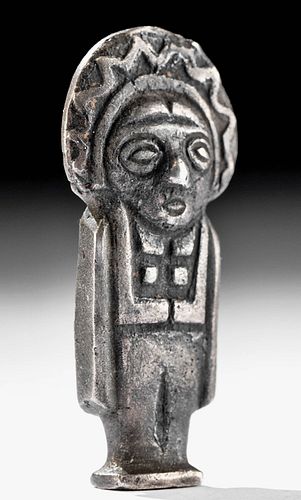Inca Ceremonial Biface Silver Amulet Standing Females
Lot 87
About Seller
Artemis Fine Arts
686 S Taylor Ave, Ste 106
Louisville, CO 80027
United States
Selling antiquities, ancient and ethnographic art online since 1993, Artemis Gallery specializes in Classical Antiquities (Egyptian, Greek, Roman, Near Eastern), Asian, Pre-Columbian, African / Tribal / Oceanographic art. Our extensive inventory includes pottery, stone, metal, wood, glass and textil...Read more
Estimate:
$6,000 - $9,000
Absentee vs Live bid
Two ways to bid:
- Leave a max absentee bid and the platform will bid on your behalf up to your maximum bid during the live auction.
- Bid live during the auction and your bids will be submitted real-time to the auctioneer.
Bid Increments
| Price | Bid Increment |
|---|---|
| $0 | $25 |
| $300 | $50 |
| $1,000 | $100 |
| $2,000 | $250 |
| $5,000 | $500 |
| $10,000 | $1,000 |
| $20,000 | $2,500 |
| $50,000 | $5,000 |
| $100,000 | $10,000 |
| $200,000 | $20,000 |
About Auction
By Artemis Fine Arts
Jan 21, 2021
Set Reminder
2021-01-21 10:00:00
2021-01-21 10:00:00
America/New_York
Bidsquare
Bidsquare : Ancient / Ethnographic From Around The World
https://www.bidsquare.com/auctions/artemis-gallery/ancient-ethnographic-from-around-the-world-6316
Ancient art from Egypt, Greece, Italy and the Near East, as well as Asian, Pre-Columbian, Native American, African / Tribal / Oceanic, Spanish Colonial, Russian Icons, Fine art, much more! All categories, all price ranges... all legally acquired and guaranteed to be as described or your money back. Artemis Fine Arts info@artemisfinearts.com
Ancient art from Egypt, Greece, Italy and the Near East, as well as Asian, Pre-Columbian, Native American, African / Tribal / Oceanic, Spanish Colonial, Russian Icons, Fine art, much more! All categories, all price ranges... all legally acquired and guaranteed to be as described or your money back. Artemis Fine Arts info@artemisfinearts.com
- Lot Description
Pre-Columbian, Peru, Inca, ca. 1400 to 1533 CE. A biface silver figurine with renderings of standing females on both sides - created to honor Pachamama (Earth Mother). Each figure (depicted on front and back) stands with arms and hands held over her chest in prayer. They are nearly identical, however, they differ in the clothing and ornamentation. One wears a large pectoral around her neck and her headdress and skirt are adorned with cross hatch motifs. The other has delineated breasts and a headdress decorated with wave-motifs. The level of detail is quite impressive with visages comprised of lidded almond-shaped eyes, pointy noses, and open mouths as if praying or chanting, one with a centrally-parted coiffure. As with other female anthropomorphic figurines of this type, the heads are relatively large in proportion to the rest of her body. A fine example with a rich symbolic context as well as an impressively hefty form. Size: 1.875" H (4.8 cm). Silver quality: 78.4%. Weight: 37 grams.
Such miniature figurines wrought in precious metals were handed over as offerings to accompany human sacrifices during the ritual of capacocha, meaning royal sin or obligation. Upon the death of an Inca king, Capacocha took place. This ritual was used to incorporate new territory into the rapidly expanding Inca empire. Local lords selected unblemished children who represented the human ideal to Cusco. These children were then married and presented with miniature human and llama figurines made of gold, silver, copper, and shell. The human figurines hold their hands clasped to their chests - a gesture of reverence. Next, the children and their figural offerings returned to their original communities. There they were ceremoniously honored before being sacrificed to the mountain gods.
Such figures were ritually deposited and regarded as sacred entities known as "huacas" (a Quechua and Aymara term). A similar example is in the collection of the Metropolitan Museum of Art (1979.206.1058). According to the Metropolitan Museum of Art curatorial department, "This figurine is similar in morphology and fabrication as ones often associated with assemblages from sites of capac hucha, or 'royal obligation,' described (Cieza de Leon 1959, 190 - 193; Diez de Betanzos 1996, 132) as an Inca state-sanctioned performance. In this practice, offerings were made in Cusco or in the hinterlands to mark the expansion of the empire and the service of the provincial peoples to the Inca royalty, in the process demonstrating reverence to certain sacred points in the natural landscape, including apus, or mountain deities, through the deposition of offerings. This pursuit of territorial control was undertaken through other tactics as well, such as the resettlement of conquered peoples and the mandate that peoples in Inca hinterlands bring huacas to Cusco and care for them there, in the imperial capital (Cobo 1979, 191). "
Provenance: ex Galeria Con Tici, Cassadaga, Florida, USA, 2011; ex Irene Lenz collection, Daytona Beach, Florida, USA
All items legal to buy/sell under U.S. Statute covering cultural patrimony Code 2600, CHAPTER 14, and are guaranteed to be as described or your money back.
A Certificate of Authenticity will accompany all winning bids.
We ship worldwide and handle all shipping in-house for your convenience.
#153204Superb save minor casting flaws. Well-preserved details. Silver has developed a wonderful patina over the centuries.Condition
- Shipping Info
-
All shipping is handled in-house for your convenience. Your invoice from Artemis Gallery will include shipping calculation instructions. If in doubt, please inquire BEFORE bidding for estimated shipping costs for individual items.
-
- Buyer's Premium



 EUR
EUR CAD
CAD AUD
AUD GBP
GBP MXN
MXN HKD
HKD CNY
CNY MYR
MYR SEK
SEK SGD
SGD CHF
CHF THB
THB















